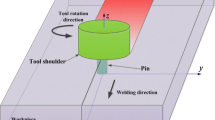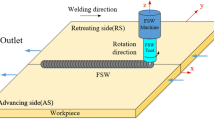Abstract
A three-dimensional friction stir welding (FSW) process model has been developed based on fluid mechanics. The material transport in the welding process has been regarded as a laminar, viscous, and non-Newtonian liquid that flows past a rotating pin. A criterion to divide the weld zone has been given on the basis of cooperation of velocity field and viscosity field. That is, the η 0-easy-flow zone that existed near the tool pin corresponded to the weld nugget zone; the area between the η 0-easy-flow zone and η 1-viscosity band is corresponded to the thermal-mechanical affected zone (TMAZ). The model gives some useful information to improve the understanding of material flow in FSW through the simulation result of velocity distribution. In order to appraise the friction stir pin design, three kinds of pin geometry, one is column pin, the second is taper pin, and the last one is screw threaded taper pin, were used in the model. The pin geometry seriously affected the simulation result of velocity distribution in the η 0-easy-flow zone. The velocity distribution in the η 0-easy-flow zone can be considered as the criterion of optimizing friction stir tool design. This study will benefit to direct the friction stir tool design.
Similar content being viewed by others
References
Jones M J, Heurtier P, Desrayaud C, et al. Correlation between microstructure and microhardness in a friction stir welded 2024 aluminium alloy. Scripta Materialia, 2005, 52(8): 693–697
Song M, Kovacevic R. Thermal modeling of friction stir welding in a moving coordinate system and its validation. International Journal of Machine Tools and Manufacture, 2003, 43(6): 605–615
Murr L E, Liu G, McClure J C. A TEM study of precipitation and related microstructures in friction-stir-welded 6061 aluminium. Journal of Materials Science, 1998, 33(5): 1243–1251
Li Y, Murr L E, McClure J C. Solid-state flow visualization in the friction-stir welding of 2024 Al to 6061 Al. Scripta Materialia, 1999, 40(9): 1041–1046
Ouyang J H, Kovacevic R. Material flow and microstructure in the friction stir butt welds of the same and dissimilar aluminum alloys. Journal of Materials Engineering and Performance, 2002, 11(1): 51–63
Larsson H, Karlsson L, Stoltz S, et al. Joining of dissimilar Al-alloys by friction stir welding. In: 2nd International Symposium on Friction Stir Welding. Gthenburg, Sweden, June, 2000
Guerra M, Schmidt C, McClure J C, et al. Flow patterns during friction stir welding. Materials Characterization, 2002, 49(2): 95–101
Shinoda T. Effect of tool angle on metal flow phenomenon in friction stir welds. In: 3rd International Symposium on Friction Stir Welding. Kobe Exhibition Hall, Kobe, Japan, September, 2001
Colligan K. Material flow behavior during friction stir welding of aluminum. Welding Journal, 1999, 78(7): 229–237
Seidel T U, Reynolds A P. Visualization of the material flow in AA2195 friction-stir welds using a marker insert technique. Metallurgical and Materials Transactions A, 2001, 32(11): 2879–2884
Reynolds A P, Seidel T U, Simonsen M. Visualization of material flow in an autogenous friction stir weld. In: 1st International Symposium on Friction StirWelding. Thousand Oaks, USA, June, 1999
London B, Mahoney M, Bingel W, et al. Experimental methods for determining material flow in friction stir welds. In: 3rd International Symposium on Friction Stir Welding. Kobe Exhibition Hall, Kobe, Japan, September, 2001
London B, Mahoney M, Bingel W, et al. Material flow in friction stir welding monitored with Al-SiC and Al-W composite markers. In: Friction Stir Welding and Processing II. The Minerals, Metals and Materials Society (TMS), 2003, 3–12
Schneider J A, Nunes A C. Thermo-mechanical processing in friction stir welds. In: Friction StirWelding and Processing II. The Minerals, Metals and Materials Society (TMS), 2003, 43–54
Xu S, Deng X, Reynolds A P, et al. Finite element simulation of material flow in friction stir welding. Science and Technology of Welding and Joining, 2001, 6(3): 191–193
Seidel T U, Reynolds A P. Two-dimensional friction stir welding process model based on fluid mechanics. Science and Technology of Welding and Joining, 2003, 8(3): 175–183
Seidel T U. The development of a friction stir welding process model using computational fluid dynamics. The University of South Carolina, 2002
Colegrove P, Painter M, Graham D, et al. 3-Dimensional flow and thermal modeling of the friction stir welding process. In: 2nd International Symposium on Friction Stir Welding. Gothenburg Sweden, June, 2000
Hyoe T, Colegrove P A, Shercliff H R. Thermal and microstructure modeling in thick plate aluminium alloy 7075 friction stir welds. In: Friction Stir Welding and Processing II. The Minerals, Metals and Materials Society (TMS), 2003, 33–43
Colegrove A, Shercliff H R, Philip L. Modeling and development of the Trives-TM friction stir welding tool. In: 4th International Symposium on Friction StirWelding. Park City, Utah, USA, May, 2003
Sheppard T, Wright D S. Determination of flow stress. Part 1: Constitutive equation for aluminum alloys at elevated temperatures. Metals Technology, 1979, (6): 215–223
Zienkiewicz O C, Cormeau I C. Visco-plasticity — plasticity and creep in elastic solids — a unified numerical solution approach. International Journal for Numerical Methods in Engineering, 1974, 8(4): 821–845
Sheppard T, Jackson A. Constitutive equations for use in prediction of flow stress during extrusion of aluminum alloys. Materials Science and Technology, 1997, 13: 203–209
Thomas W M, Johnson K I, Wiesner C S. Friction stir welding — recent developments in tool and process technologies. Advanced Engineering Materials, 2003, 5(7): 485–490
Author information
Authors and Affiliations
Corresponding author
Rights and permissions
About this article
Cite this article
Lin, SB., Zhao, YH., He, ZQ. et al. Modeling of friction stir welding process for tools design. Front. Mater. Sci. 5, 236–245 (2011). https://doi.org/10.1007/s11706-011-0128-2
Received:
Accepted:
Published:
Issue Date:
DOI: https://doi.org/10.1007/s11706-011-0128-2




